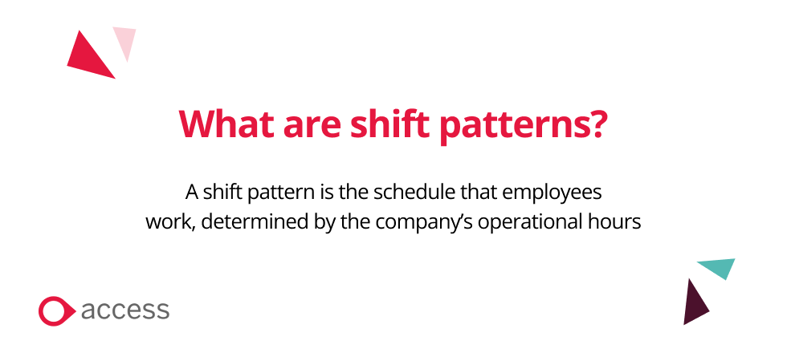
What are shift patterns?
A shift pattern is the schedule that employees work, determined by the company’s operational hours. Shift patterns usually include a mix of morning, afternoon and evening work and may also involve night shifts too. In typical shift patterns, employees work a set schedule each week with days off in between, often working a minimum of five days per week but never more than seven in a row. Some frequently used shift patterns include:
- Two-shift
- Four on, four off
- Night work
- Staggered day
What types of shift patterns are there?
With so many different shift pattern options available, small businesses may find it difficult to understand the meaning behind each of them and how they work in practise. Let’s look at seven common types of shift working patterns and provide an example for each.With so many different shift pattern options available, small businesses may find it difficult to understand the meaning behind each of them and how they work in practice. Choosing the right pattern can impact productivity, employee satisfaction, and operational efficiency.
Let’s look at seven common types of shift working patterns, explain how they work, and provide an example for each.

1. Two-shift
A two-shift patterns involves rotating two different shifts which cover the entire day. Typically implemented for Monday to Friday working hours, there is usually a morning shift and an evening shift.A two-shift pattern involves rotating two different shifts that cover the entire day. Typically implemented for Monday to Friday working hours, there is usually a morning shift and an evening shift.
Why use it?
- Pros: Simple to manage, ensures full-day coverage without overworking staff.
- Cons: Limited flexibility for 24/7 operations, may require overtime for unexpected demand.
Example of two-shift pattern
The morning shift worker might start work at 6am and finish at 2pm, while the evening shift takes over from 2pm and finish at 10pm, providing cover throughout the day. . This setup ensures continuous coverage during business hours without overlap.
2. Four on, four off
The four on, four off work pattern requires an employee to work four days consecutively, then have four days off. The four days on usually consists of 12-hour shifts each. The four on, four off work pattern requires an employee to work four consecutive days, then have four days off. Each working day usually consists of 12-hour shifts, making it popular in industries that need round-the-clock coverage.
Why use it?
- Pros: Predictable schedule, longer rest periods, good for 24/7 operations.
- Cons: Long shifts can be tiring, harder to manage for part-time staff.
Example of four on, four off shift pattern
A nurse may work from 7pm to 7am for four consecutive nights as part of their four-shift pattern. Once completed they would then have the next four days off to rest before returning to work.
3. Night shift
An employee will work throughout the night, with the shift usually starting in the evening and finishing the following morning. This schedule is often required for 24-hour operations such as security or healthcare. Night shifts cover hours when most businesses are closed, typically starting in the evening and finishing the following morning. This is essential for 24-hour operations like healthcare, security, and manufacturing.
Why use it?
- Pros: Keeps operations running overnight, ideal for global businesses
- Cons: Can disrupt sleep patterns, higher risk of fatigue.
Example of night shift pattern
An example of night shift patterns would be a security guard working from 10pm to 6am. In this instance they may be monitoring surveillance cameras to ensure the security of the premises during quieter nighttime hours.
4. Weekend
Weekend shift work patterns take place over Saturdays and Sundays but can sometimes include Fridays depending on the business. This is common for those in the hospitality industry, where busy weekends require full staff coverage. Weekend shift work patterns cover Saturdays and Sundays, sometimes including Fridays. This is common in hospitality, retail, and entertainment, where weekends are the busiest.
Why use it?
- Pros: Meets peak demand, good for part-time or student workers.
- Cons: May be less appealing for full-time staff who value weekends off.
Example of weekend shift pattern
A restaurant worker may be required to work full days over Saturday and Sunday but have rest days during the week.
5. Staggered day
A staggered day shift pattern usually consists of five eight-hour days over the course of a seven-day week. Start times are staggered throughout the day to accommodate operational needs. A staggered day shift pattern spreads start times across the day to cover extended operating hours without requiring overtime. Employees still work five eight-hour days, but start times vary.
Why use it?
- Pros: Great for businesses open beyond 9–5, reduces idle time.
- Cons: Harder to coordinate team meetings, can feel inconsistent for staff.
Example of staggered day shift pattern
For operational hours outside of a 9-5 schedule, such as 9am to 9pm, employees may be expected to start at 9am, 11am, and 1pm respectively, which will cover the entire 12-hour day.
6. Twilight and evening
Twilight and evening shift working patterns are started late afternoon and go into the evening, usually between 5pm and 9pm. This option is popular for retail as it accommodates customers who are shopping after regular business hours. Twilight and evening shifts start in the late afternoon and run into the evening, typically between 5pm and 9pm. This is popular in retail and customer service, where demand peaks after standard working hours.
Why use it?
- Pros: Ideal for part-time staff or students, meets after-work customer demand.
- Cons: Limited hours, may not suit those with evening commitments.
Example of twilight and evening shift pattern
A retail store might schedule its sales associates to work from 3pm to 9pm, or until the store closes.
7. Continental
For a continental shift pattern, employees work a rotating schedule which provides 24-hour coverage, including both day and night shifts. Instead of everyone working the same hours each day, they take turns working different shifts. A continental shift pattern uses a rotating schedule to provide 24-hour coverage, including both day and night shifts. Employees take turns working different shifts, ensuring fairness and continuous operation.
Why use it?
- Pros: Perfect for manufacturing or transport, ensures constant coverage.
- Cons: Complex to manage, can disrupt personal routines.
Example of continental shift pattern
A transportation worker may have three day shifts followed by two days off, then three night shifts then a four-day break.
What laws impact shift work pattern regulations in the UK?
The Working Time Regulations 1998 are a set of laws which establish how much an employee can work within a set period of time. It is crucial for businesses to understand these regulations when planning and implementing shift work patterns.
The regulations dictate that:
- An employee can work no more than 48 hours a week
- A 20-minute rest period for every six hours worked is provided
- Employees are offered a minimum daily rest period of 11 consecutive hours between working days
There are also provisions in place for young workers and those who work night shifts, so these must be taken into consideration too. Our article on Working Time Regulations explains the topic in more detail.
3 ways to manage shift working patterns effectively
Once you have grasped the different shift work patterns and chosen the right one for your specific operational needs, your next step is to implement accordingly. However, it is important to manage this correctly both to maximise your outputs and for employee satisfaction.
Here are 3 ways to manage shift working patterns successfully:
Understand business needs
When a company has a comprehensive overview of their operational requirements including when they need additional staffing or reduced hours, alongside broader legal requirements, they can get this process right.
When looking at shift working patterns, it is crucial to have an understanding of business needs and the staff availability. This means that employers can design shift schedules that boost productivity while also taking into account busier periods or seasonal needs alongside the all-important legal requirements.
Ensure transparency and clear communication
Providing employees with information regarding their working schedules well in advance will help to keep everything running smoothly and help with engagement and morale.
By offering employees details of their work schedules well in advance, you can ensure shifts run smoothly. It is also important to have open communication with employees about their preferences and availability when making rota-based decisions. For example, if an employee prefers to work a morning or evening shift and this fits in with the rota, then try to accommodate this where possible.
Utilise timesheet software
Using cloud-based timesheet software can help to simplify the scheduling of shift patterns, as well as offer visibility and easy tracking options to both employees and employers. By tracking the attendance of employees using automated timesheets, you can gain insights into what shift patterns work best for your needs and make data-driven decisions.
FAQ's
1. What laws govern shift patterns in the UK?
Shift patterns in the UK are primarily governed by the Working Time Regulations 1998, which set out rules on:
Maximum weekly hours: Employees cannot work more than 48 hours per week on average, over a 17-week period (unless they opt out in writing).
Rest breaks:
- At least 20 minutes if working more than 6 hours a day.
- 11 consecutive hours of rest in any 24-hour period.
- One full day off per week (or two days every 14 days).
Night work: Night workers (working between 11pm and 6am) cannot work more than 8 hours in any 24-hour period, on average. They are also entitled to regular health assessments.
Young workers: Under-18s have stricter limits (max 8 hours per day, 40 per week, and no night work).
Employers must also comply with health and safety obligations and avoid discrimination when scheduling shifts.
2. Can I as an employer change a shift pattern without notice?
Generally, no. You cannot unilaterally change an employee’s shift pattern if it forms part of their employment contract. Doing so without agreement could be a breach of contract.
If hours are fixed in the contract: You need the employee’s consent to make changes.
If hours are flexible (rota-based): You can make changes, but they must be reasonable and with adequate notice. While the law does not define “reasonable notice,” best practice is:
- 12–24 hours for a single shift change.
- At least one week for significant rota changes.
New legislation: Workers now have a right to reasonable notice of shift changes, and employers may face penalties for last-minute cancellations.
3. Can employees change work shift patterns?
Yes. Employees have a statutory right to request flexible working from day one of employment (previously 26 weeks). They can make two requests per year, and employers must:
- Respond within two months.
- Consult with the employee before refusing.
- Only refuse for a valid business reason (e.g., cost, impact on performance, inability to reorganise work).
Employees can also make informal requests, but any agreed change should be confirmed in writing as it alters the employment contract.
How can PeopleHR help you with shift pattern management
Our Timesheet Software can assist you in managing your chosen shift patterns with ease, offering scheduling, tracking and self-serve functionalities. Find out how our suite of HR Software can help your business thrive by getting in touch today.
